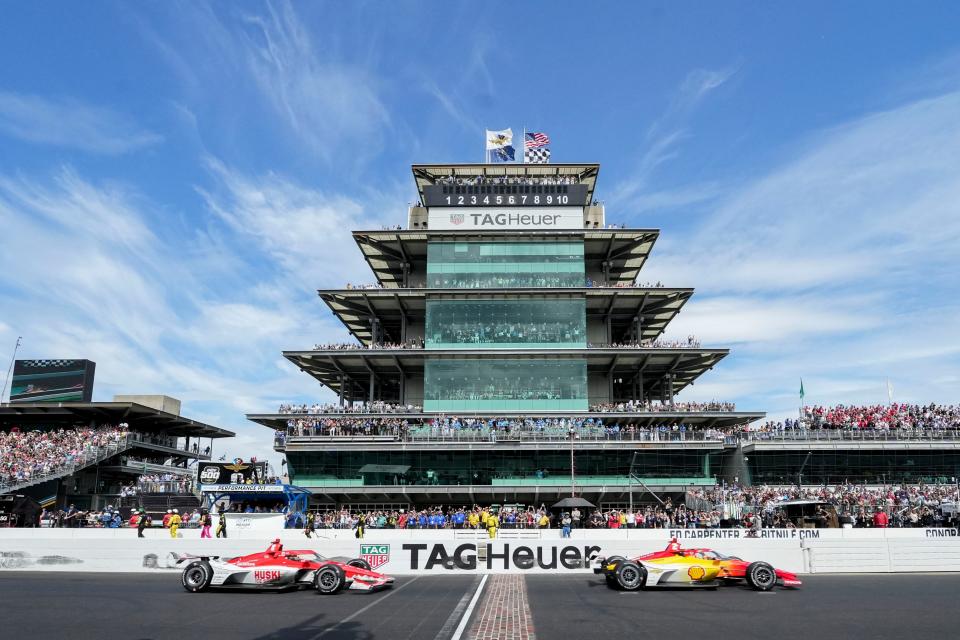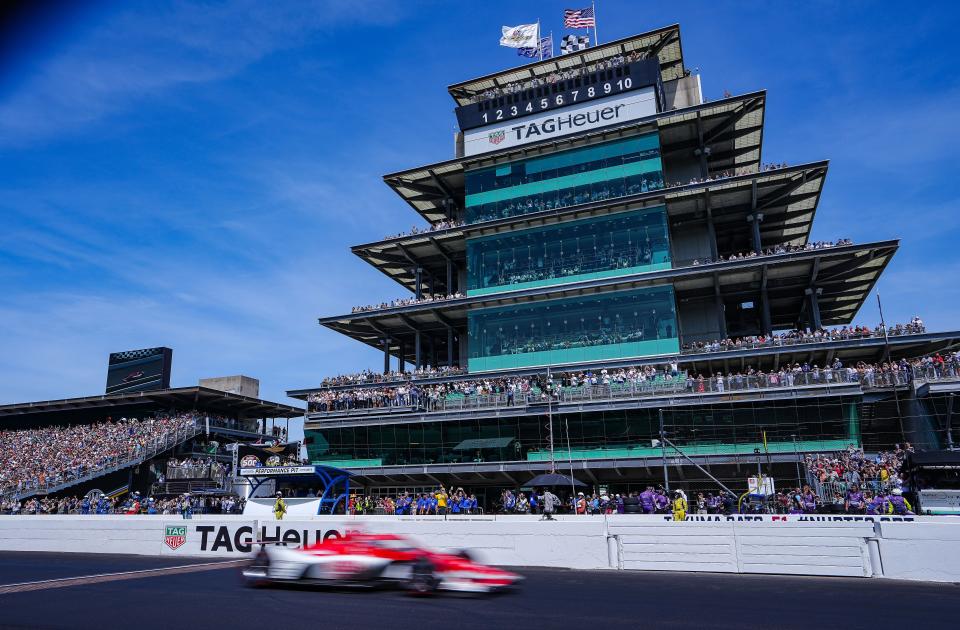Josef Newgarden's winning Indy 500 move made illegal. How it'll be officiated is unclear.
IndyCar officials have confirmed a long-expected and highly impactful change to what drivers are allowed to do to break a trailing car's draft coming onto the front straightaway in the Indianapolis 500. But the series admits the finer points of the rule haven't been finalized less than 100 days until the race.
In an extensive interview Friday afternoon with IndyStar, Indianapolis Motor Speedway president Doug Boles admitted even he didn’t know.
“I know what you know, which is it’s a move that isn’t going to be allowed, but to what extent that means a car can cross that (pit lane commitment) line, I don’t think we know yet,” Boles said.
That move, widely known as ‘The Dragon’ in the wake of Marcus Ericsson’s charge to Victory Lane in 2022, involves the leading driver diving dangerously low on the track coming out of Turn 4 to prevent a pass before reaching the checkered flag.

Ericsson picked it up from 2019 winner Simon Pagenaud, who credits two-time winner Juan Pablo Montoya’s 2015 victory with its first mainstream use in the 500. In rewatching the end of the 2019, 2022 and 2023 500s, the move has developed swiftly over time, from Pagenaud only briefly dropping four wheels past the solid white pitlane commitment line, to Ericsson only barely dipping lower – but weaving far more aggressively on the straights in hopes of breaking Pato O’Ward’s draft – to last year, after which IndyCar president Jay Frye and his race stewards decided a change must be made.
It's called The Dragon: How Marcus Ericsson's controversial (but legal) move won Indy 500
On Newgarden’s run off Turn 4, the Team Penske driver had his No. 2 Chevy aimed squarely for the outside of pitlane, flirting with contact with the attenuator that divides the track and pitlane and crossing a dotted white line connecting the attenuator and the end of Turn 4 in the process.
In a statement provided to IndyStar, the series says that as part of its “annual offseason review,” Newgarden’s drastic move to the inside “was within the rulebook,” but that move will not be allowed in the future.
“Looking ahead to the 2024 Indy 500, the line will be updated to a solid line and will be officiated,” the statement continued. “The appropriate penalty is still being finalized.”
According to the latest published version of IndyCar’s rulebook, penalties for such an infraction could include lap or time penalties, as well as being forced to give up the spot the driver was attempting to defend, disqualification or being shown the black flag.
The rules update could have rules officials altering the results of the race after the checkered flag has fallen, should a driver dip too low, successfully hold off its competitors and then take the checkered flag within seconds – before race control has time to announce a penalty. And depending on the penalty chosen, it could mean the difference between a rule-breaker being moved from 1st to 2nd, or perhaps to the end of the lead lap (which last year would’ve been 17th).
“If it happens on the last lap of the race, how do you enforce that?” Boles wondered. “That’s stuff IndyCar will continue to think through and then ultimately share with us as we go forward. I guess the good news in it is that the race is competitive enough that, at the end of the day, that’s something we have to worry about because these last couple years, it’s come down to that last corner.”
But the lack of clarity on a penalty is far from the only question mark IndyCar has left as it’s rolled out this new rule halfway. Here are other important implications to consider:

What is an infraction?
Drivers dipping two – and sometimes even four – wheels below the solid white lines on the track has long been common practice for front-runners near the end of the 500. Only in recent years has the move become more exaggerated. From video review, it appears the dotted white line visible in last year’s race that connected the attenuator and the inside barriers of Turn 4 was a new additions, making it that much clearer just how deep – and early – Newgarden was darting inside to shake Ericsson in the final few hundred yards of the race.
Now with a solid line extending from Turn 4 all the way to pitlane, where will it be illegal for drivers to have their car below the white line? Will two wheels below the line be considered an infraction – and if so, is that just the car touching the white line, or a car’s two wheels running fully below the white? Or does a driver have to have their entire car headed towards pitlane, as Newgarden, Ericsson and others did on last year’s final lap, in order for race control to deem the move illegal?
What happens if a leader breaks the rule in the closing laps, and drivers trying to find a way to pass them follow the leader down too low – are those trailing cars also in line for a penalty?
More: Here are the broadcast start times for the 2024 IndyCar season

What can leading drivers still do to defend?
In 2022, Ericsson’s winning moves garnered more attention for the way in which he weaved his No. 8 Honda back-and-forth on the straightaways, rather than how dangerously close he hugged the attenuator – contact with which at 230 mph or so could prove devastating. In defense of his 500 victory this past year in Lap 200, while coming off Turn 2 and onto the backstraight, Ericsson dove his entire car well beneath the white line in a desperate attempt to break Newgarden’s draft as the No. 2 Chevy inched closer and eventually overtook the Ganassi driver for a race-clinching pass.
That move has been deemed legal due to the leading cars proactively darting left or right, rather than in reaction to a car behind them. Because passing has been so tough, trailing cars have needed to follow the car in front’s every move, in hopes of finally swinging out before a corner to make an outside move. That has trailing cars reacting to the leader’s move.
So, as long as it’s between the inside white line and the outer track walls, will drivers – and more importantly leading cars – still be allowed to make an unlimited number of proactive moves down the straight? Or will drivers be allowed to make a set number of defensive moves on a straightaway, giving a trailing car better opportunities to map out a pass, rather than having to focus on staying in touch with the car ahead?
And will those rules be for the front and back straightaways, despite their obvious differences, in terms of safety concerns with drivers who might dip too far inside and lose control? IndyCar race control’s calls this May will only be looked at more closely, as rule changes and their proper application could very well decide the winner.
This article originally appeared on Indianapolis Star: Indy 500: The Dragon is illegal. How it'll be officiated is unclear.
